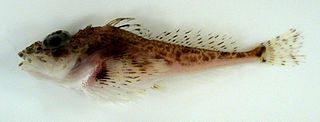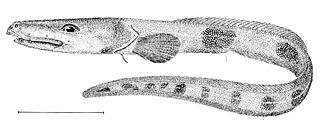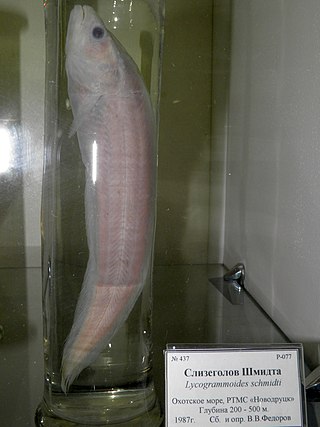The eelpouts are the ray-finned fish family Zoarcidae. As the common name suggests, they are somewhat eel-like in appearance. All of the 300 species are marine and mostly bottom-dwelling, some at great depths. Eelpouts are predominantly found in the Northern Hemisphere. The Arctic, north Pacific and north Atlantic oceans have the highest concentration of species; however, species are found around the globe.

The scaled sculpins, Icelus, are a genus of marine ray-finned fishes belonging to the family Cottidae, the typical sculpins. Most of the fishes in this genus are found in the northern Pacific Ocean but they also occur in the North Atlantic Ocean.

Bothrocara is a genus of marine ray-finned fishes belonging to the family Zoarcidae, the eelpouts. They are found in the Pacific Ocean with one species reaching the southwestern Atlantic Ocean.
Petroschmidtia is a genus of marine ray-finned fishes belonging to the family Zoarcidae, the eelpouts. The species in this genus are placed in the genus Lycodes by FishBase but Catalog of Fishes recognises this as a valid genus.
Lycodes vahlii, Vahl's eelpout or the checker eelpout, is a species of marine ray-finned fish belonging to the family Zoarcidae, the eelpouts. It is native to coasts of Northern Atlantic Ocean.

Lycodichthys is a genus of marine ray-finned fish belonging to the family Zoarcidae, the eelpouts. They are found in the Southern Ocean.

Lycenchelys is a genus of marine ray-finned fishes belonging to the family Zoarcidae, the eelpouts. The genus has almost cosmopolitan distribution.
Lycodinae is a subfamily of marine ray-finned fish belonging to the family Zoarcidae, the eelpouts. These eelpouts are found are in all the world's oceans, with a number of species being found off southern South America.

Austrolycus is a genus of marine ray-finned fishes belonging to the family Zoarcidae, the eelpouts. The two species in this genus are found in the southeastern Pacific Ocean and the western South Atlantic Ocean off southern South America and the Falkland Islands.
Bothrocarina is a genus of marine ray-finned fishes belonging to the family Zoarcidae, the eelpouts. The two species in this genus are found in the Northwestern Pacific Ocean.
Dieidolycus is a genus of marine ray-finned fishes belonging to the family Zoarcidae, the eelpouts. The genus comprises three species which are found in the western central Pacific, southeastern Pacific and Southern Oceans.
Japonolycodes is a monospecific genus of marine ray-finned fish belonging to the family Zoarcidae, the eelpouts. The only species in the genus is Japonolycodes abei. This species is found Northwestern Pacific Ocean off Japan.
Lycodapus is a genus of marine ray-finned fishes belonging to the family Zoarcidae, the eelpouts. The species in this genus are found in the Pacific and Southern Oceans.
Lycodes gracilis, Vahl's eelpout or the gracile eelpout, is a species of marine ray-finned fish belonging to the family Zoarcidae, the eelpouts. It is found in the eastern North Atlantic Ocean and adjacent areas of the Arctic Ocean.
Lycodes esmarkii, Esmark's eelpout or the greater eelpout, is a species of marine ray-finned fish belonging to the family Zoarcidae, the eelpouts. This species is found in the North Atlantic Ocean.
Lycodonus is a genus of marine ray-finned fish belonging to the family Zoarcidae, the eelpouts. The species in this genus are found in the North and Southern Atlantic Ocean. These fishes are sometimes called scutepouts.

Lycogrammoides is a monospecific genus of marine ray-finned fish belonging to the family Zoarcidae, the eelpouts. Its only species is Lycogrammoides schmidti, a rare species of the Sea of Okhotsk in the northwestern Pacific Ocean.
The bearded eelpout is a species of marine ray-finned fish belonging to the family Zoarcidae, the eelpouts. This species is the only species in the monospecific genus Lyconema. It is found in the eastern Pacific Ocean.
Pyrolycus is a genus of marine ray-finned fishes belonging to the subfamily Lycodinae, the eelpouts, within the family Zoarcidae. The genus was first described in 2002 by Japanese ichthyologists Yoshihiko Machida and Jun Hashimoto. The type species is P. manusanus, which was discovered in the Manus Basin off Papua New Guinea.
Lycozoarces is a monospecific genus of marine ray-finned fish belonging to the family Zoarcidae, the eelpouts, its only species being Lycozoarces regani. It is the only genus in the monogeneric subfamily Lycozoarinae. This taxon occurs in the northwestern Pacific Ocean in the Sea of Okhotsk and the Tatar Strait in the northern Sea of Japan.








